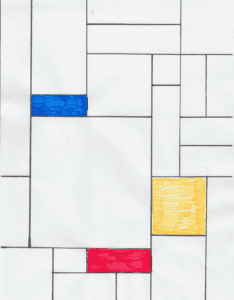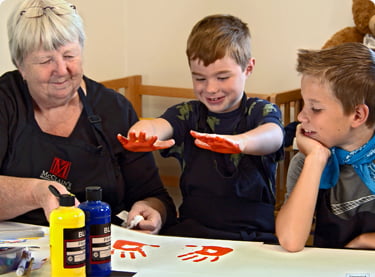
A meaningful way to encourage creativity in children is through learning about notable artists from the past. By incorporating the styles of famous artists into their own projects, children can develop a deeper appreciation for the creative process – and this is one of the key reasons why kids need art in their curriculum.
Piet Mondrian was a Dutch abstract painter who lived from 1872 to 1944. His early, figurative painting style evolved into an abstract style that influenced many art movements of the 20th century. In this lesson, Barbara Mason discusses his life and distinctive use of color and geometry that continue to resonate in the work of fashion designers and commercial artists.
Learn About Piet Mondrian’s Life and Art Video
Join Barbara as she discusses the life and work of Dutch artist Piet Mondrian, including his recognizable use of shapes, form and color.
Piet Mondrian, Dutch Abstract Painter Lesson Plan
Mondrian Frame 1
Piet Mondrian and the Concept of Abstract Art
Read along, using the video transcription below, as you watch Barbara Mason discuss Piet Mondrian’s transition from a landscape and portrait painter to an innovative abstract artist.
Golden Road Arts is a nonprofit that offers art classes for kids so they can make the most of their own creativity. At Golden Road Arts, we believe that children’s access to Art is the key to reaching their full potential. Using simple materials usually found around the house, we explore the basics of the creative process. Together with Barbara, her sidekick Artey art bear and other Northwest artists, we invite you to join us on our creative adventure along the Golden Road.
This is Barbara Mason. Welcome to Golden Road Arts. You can see I still have my mask on even though we’re getting closer and closer to being able to beat the back of the virus until everybody is vaccinated. We still have to be real careful, but I’m going to take my mask off so it would be easier for me to talk to you while we’re doing the video.
Today we’re going to do a really fun thing. We’re going to have a color of the day, an artist of the day and the shape of the day. And so our color of the day is going to be red – actually red, yellow and blue. Our shape of the day is going to be a square or a rectangle and our artist of the day is going to be a man named Piet Mondrian.
It’s kind of a hard name to say, isn’t it? It’s a very very unusual spelling. Piet was born in 1872, now 1872 is almost a hundred fifty years ago, so this is a really long time ago. He was born in the Netherlands. He was a Dutch painter. Everybody who is an artist pretty much knows who Mondrian was, because he was famous. He started out just like every artist. He started painting the things around him, painting his neighborhood, painting horses, and trees, and you know his town. Then as he got to be a better and better artist, he decided that he didn’t want to paint things that were just pretty settings. He thought that painting was so special to him that he thought it was more important to paint things that made people feel that kind of evoked an emotion. He thought the painting was so important, and he kept refining it down and down and down until he became what’s known as an abstract painter.
Now abstract is kind of a funny word. People have a lot of different meanings for abstract, a lot of different things they think it is. But really what abstract means is to take something and refine it down to its essence. So the tiniest thing you can make out of something would be an abstract, and they talk about abstracts in writing. So you take a book, and if you make an abstract out of a book, you can do it in just a couple pages, and it’s really just like a little quick telling of the tail.
So Mondrian decided he was only going to use three colors in his work. The colors were red, yellow and blue. We talked previously about the color wheel. I think the reason he chose red, yellow and blue is because all the other colors can be made from red, yellow and blue.
He decided to only use black lines, and he decided that they were only going to go straight across, and straight up and down. So in some of our previous lessons, we talked about vertical lines and horizontal lines. And so these are the lines he chose, straight up and down, and straight across. He started doing all his work like that.
He did work where he only used one color, so he would take a piece of paper like this with lines on it. and you can see I’ve a couple of these here. We’re going to copy these and put them on the Internet so you can use these, or you can make your own. What he did is he would say, okay, this is going to be my red composition, and he would make one little section of this red. And that would be his red composition, and he has a couple of these that are done like this, and they’re called composition in red.
So really the black lines are as important as the color, because the black lines hold the color, sort of to give it a form. You can see it’s pretty interesting to have something with only one color on it. But then he started doing things with all three colors. And sometimes he would do red and blue on the same painting. And other times he would do red, blue and yellow.
He left the Netherlands, and he moved to Paris. A lot of artists moved to Paris around the turn of the century. So at the turn of the century, which would have been 1900, so long time ago. He decided that he would go to Paris where all the artists were in Paris, and it was just a really amazingly fun time to be an artist. His art was pretty groundbreaking. A lot of artists really like his work. Some didn’t like it. Some people thought he was crazy. Just like always when you’re an artist, some people who appreciate you, and some people don’t. If you’re an artist, you’re just kind of making things that you like, if you start making things that other people like, pretty soon you find you don’t do as good work, and you don’t like your work as much. So I’m supporting to make things that you like.
Okay, so here we have a little Mondrian composition. And so there’s quite a few of these compositions that are done like this with only a few colors. So what we’re going to do is we’re going to put some samples from the internet for you to look at, and we’re also going to have a template for you to actually print out if you want. But if you want to make your own, it’s kind of hard to draw straight lines. And so I have a piece of cardboard here. I’m going to use that I could use as a kind of a ruler. I can put this piece of cardboard here on my paper, and I could make a line right across. I’ve got a black pan here somewhere. There we go. Okay, so I could draw a right on the edge of that cardboard to make a black line right across my paper, just like that. Maybe I’ll do one here. And maybe I’ll do one up here. So what if you don’t have a piece of cardboard? What if at home you’ve got paper, but you don’t have a piece of cardboard. How are you going to get a perfectly straight line? One of the things you could do is you can take a piece of paper like this, and you can if you just draw on the edge of a paper it’s really hard to do because it’s too soft, but you could fold it. Then you could fold it again. So now you have an edge here. It’s not as hard as cardboard, but it’s pretty hard. You could lay your paper here. You could say okay, this is going to be my straight line. So I’m going to come down like this. And then I’m going to skip that one, and I’m going to come down here. And then maybe I’m going to come over here. I want to make a line here. Maybe I’m going to make a line here as well. I’m going to go all the way to the bottom. So because this is your work you can do it any way you want.
Now when Mondrian did all these pieces that were so groundbreaking. His theory was that art was so special to him, what he thought was the only thing that mattered. So he just wanted to make it really special and everyone liked his work. I mean artist used it. They used it for advertising. There were some famous designers who used Mondrian’s work for their clothes. So his work was really really special.
He moved to New York during the second world war, and live the last few years of his life in New York. He died in 1944. That’s almost 75 years ago, so long time ago. We could take other colors. We wouldn’t have to use the three colors that Mondrian used. We could say gosh, you know, what I’m going to do. I’m going to use orange instead of red. And I’m going to make my squares orange because really this is your work and you can do it. anyway you want.
It’s important to remember these artists because they were very very instrumental in changing the way people looked at Art. Before that before these artists came along with started to do abstract work, people looked at art in the same way. They just wanted it to look very much like something they could see. So they went outside they saw horse, and a tree, and park, and maybe a fence. That’s what they thought the art should look like. They did not think that it should look like squares colored with red, yellow and blue.
So what do you think of this work? What do you think of Mondrian’s work? Do you think you would like to make work that’s just squares? or do you think you would like to make work that looks like trees, and houses, and roads, maybe cars, things that you see every day? So now I wouldn’t have to use red, yellow and blue, I could use this color. this is kind of a green blue color. What’s it called? Its called Robin’s egg blue. Wonder who names these things, they all have names. Figures out the names for the crayons.
I think they have a hundred and forty-eight crayons now, so there’s a lot of names. Okay, so now we’ve got our orange and our blue. So we made our own Mondrian image with our own colors. We have a third color too. What do you think our third color should be? Maybe our third color should be purple. Is this purple? Oh, blue violet. So we’ve made a piece that looks kind of like Mondrian. But we’ve used our own colors, and we’ve made our own squares. So I’m hoping that in your classroom or at home. You’ll do some work that looks like Mondrian, and you’ll make your own colors on your own squares. because after all it’s your work, it doesn’t have to be red, yellow and blue, but it could be.
This work is what’s called abstract, and the other word is not objective. So not an objective means that there’s nothing in it that you can relate to. There’s not an apple. There’s not a pair. There’s not a horse. There’s not a cow. There’s not a tree. It’s just a design. So it doesn’t have an object in it that we can relate to. Anyway so I hope that you’ll look up Mondrian. And that you will check out on the internet some of his work. We’re going to put some of it on our website for you. You’ll be able to look at all. So we’re going to put a picture of him on here. We found a couple of pictures of him one that was a self-portrait and you can see he was a really good painter. So he didn’t just paint these things because he wasn’t a good painter. Most people that do abstract work start out as very very good painters, realistic painters, and then their work gets more and more and more abstract.
So thanks so much for joining me at Golden Road today. I hope that you’ll appreciate Mondrian. And remember he was a hundred and fifty years ago, really really a long time ago. And yet look at this work. doesn’t this look like something that you could see today? and you would like it maybe if you saw this on an advertising billboard, or you saw it on a can of soup. You would think wow, that’s a nice design. That’s because Mondrian was really ahead of his time. I’m going to put my mask back on because I’m leaving the room going out with everyone else, and I don’t want to make them sick and I don’t want to get sick.
Thanks again for coming to visit me and remember, our color of the day was red, actually red, yellow, and blue. Our shape of the day was a square or a rectangle. Our artist of the day was Piet Mondrian. He was born in 1872, and he died in 1944. So a long time ago, but still very very famous artist. Thanks so much for joining me today, and I’ll see you next time.
Experience the Benefits of Art With Our Free Lessons
Golden Road Arts develops art lessons to use at home or in the classroom. Browse our extensive collection of art tutorials designed to inspire and educate children on various art styles and techniques. Watch our free art lessons today, and please consider supporting our nonprofit with a donation.
Samples











